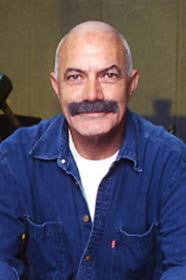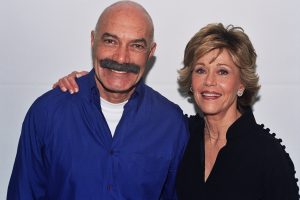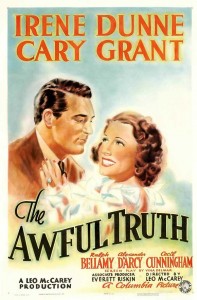 One of the best screwball comedies ever made, The Awful Truth belongs to the sub-genre of “comedy of remarriage,” in which a divorced couple begins dating new mates, but get back together at the end, so the film is about obstacles in the way to the (rather predictable) happy reunion.
One of the best screwball comedies ever made, The Awful Truth belongs to the sub-genre of “comedy of remarriage,” in which a divorced couple begins dating new mates, but get back together at the end, so the film is about obstacles in the way to the (rather predictable) happy reunion.
The script was written by Viña Delmar, with uncredited contribution from Sidney Buchman and McCarey, from the 1922 play by Arthur Richman.
Our Grade: A (***** out of *****)
The plot unfolds as a series of comic-absurdist machinations of a soon-to-be-divorced couple who go to great lengths to try to ruin each other’s romantic escapades.
Jerry Warriner (Grant) returns home from a trip to find his wife, Lucy (Dunne), is not at home. When she returns in the company of her music teacher, Armand Duvalle (Alexander D’Arcy), he learns that she spent the night with him, after his car had broken down. When she discovers that Jerry did not go to Florida as he had claimed. Mutual suspicions result in divorce.
As a punishment, Lucy moves into an apartment with Aunt Patsy (Cecil Cunningham) and becomes engaged to her neighbor, Dan Leeson (Ralph Bellamy) from Oklahoma. However, Leeson’s mother (Esther Dale) does not approve of her.
Lucy realizes that she still loves Jerry and decides to break off the engagement. However, before she informs Dan, Armand shows up at her apartment to discuss Jerry’s earlier disastrous interruption of Lucy’s singing recital. When Jerry knocks on the door, Armand decides it would be prudent to hide in the bedroom. Jerry wants to reconcile, to Lucy’s delight, but Dan and his mother show up. To avoid complications, Jerry slips into Lucy’s bedroom, too. A fight erupts when he finds Armand already there, and Jerry chases him out in front of the Leesons.
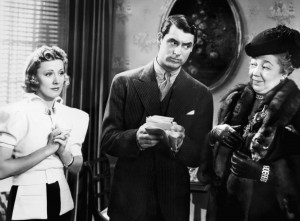 Meanwhile, Jerry is seen around town with heiress Barbara Vance (Molly Lamont). To break up this relationship, Lucy crashes a party at the Vance mansion, pretending to be Jerry’s sister. She acts like a showgirl (recreating a musical number she had seen performed by one of Jerry’s girlfriends). She claims that their “father” had been a gardener at Princeton University, not a student athlete. Motorcycle policemen stop Jerry, and Lucy, plotting to spend more time with him, sabotages the car. The couple get a lift to her aunt’s cabin from the policemen, where both admit to having made a fool of themselves.
Meanwhile, Jerry is seen around town with heiress Barbara Vance (Molly Lamont). To break up this relationship, Lucy crashes a party at the Vance mansion, pretending to be Jerry’s sister. She acts like a showgirl (recreating a musical number she had seen performed by one of Jerry’s girlfriends). She claims that their “father” had been a gardener at Princeton University, not a student athlete. Motorcycle policemen stop Jerry, and Lucy, plotting to spend more time with him, sabotages the car. The couple get a lift to her aunt’s cabin from the policemen, where both admit to having made a fool of themselves.
Their main courtroom battle centers on their pet dog, Mr. Smith (better known as Asta of the “Thin Man” film series). When Grant begins to fall for the socialite Barbara Vance (played by Molly Lamont), Dunne invades a party at Barbara’s house, pretending to be drunk and carrying on wildlyuntil Grant consents to take her home.
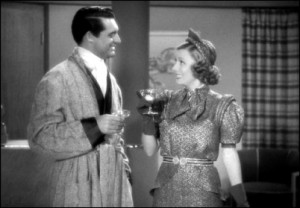 The climax occurs in the couple’s mountain retreat, where they literally play cat and mouse games. Oscar-winner Leo McCarey’s mise-en-scene is spectacular: Just watch the details in a sequence in which Grant tries to make a door that separates his room from Dunne’s open–without visible assistance and without much noise. The sequence benefits immensely from the sharp editing of Al Clark, who was nominated for an Oscar.
The climax occurs in the couple’s mountain retreat, where they literally play cat and mouse games. Oscar-winner Leo McCarey’s mise-en-scene is spectacular: Just watch the details in a sequence in which Grant tries to make a door that separates his room from Dunne’s open–without visible assistance and without much noise. The sequence benefits immensely from the sharp editing of Al Clark, who was nominated for an Oscar.
Irene Dunne, in a well-deserved Best Actress Oscar nomination, has a way with a quip, as the critic Pauline Kael noted, “Dunne smiles brightly before wringing it dry, really dry.” Grant was not Oscar-nominated, but Bellamy was (in the supporting category).
Ralph Bellamy plays the third wheel, Daniel Leeson, a wealthy oil heir from Oklahoma, a similar role he would play in Howard Hawks’ “His Girl Friday,” in 1940. The cast also includes Esther Dale, Cecil Cunningham, Alex D’Arcy, and Joyce Compton, as the nightclub performer whom Dunne Parodies
Literary Source: Versions and Remakes
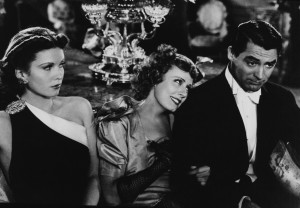 The script, based on a 1921 Broadway comedy, was filmed as a silent in 1925, and then as a talkie in 1929 with Ina Claire, and again in 1937. The screwball comedy was poorly remade in 1953, with the title “Let’s Do It Again.”
The script, based on a 1921 Broadway comedy, was filmed as a silent in 1925, and then as a talkie in 1929 with Ina Claire, and again in 1937. The screwball comedy was poorly remade in 1953, with the title “Let’s Do It Again.”
Nomination for writer Vina Delmar (the husband-and-wife team that worked together under the wife’s name). Dwight Taylor did the first draft with work by Mary McCall Jr. Additional work by Sidney Buchman, Dorothy Parker, and Alan Campbell. But it’s McCarey, who added sophisticated tongue-in-cheek dialogue and also encouraged the leads to improvise, who deserves the most praise for making a chestnut for the ages–for some critics, it is the epitome of American screwball comedy.
The comedy contains many priceless scenes and lines of dialogue. Consider the sequence in which Grant standing behind the door, tickling Dunne with a pencil, making her giggle to the bewilderment of her fiancé.
And the line, “I guess a man’s best friend is his mother,” which is often attributed to Anthony Perkins in Psycho, is delivered here in earnest by Bellamy’s Dan Leeson as he walks out accompanied by his mother.
Cary Grant Screen Persona
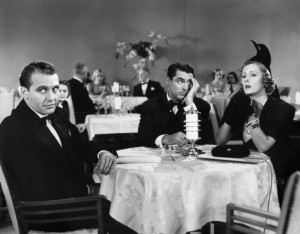 The Awful Truth marked the first showing of Cary Grant’s light comedy persona, which he used in most of his subsequent films, catapulting his career to worldwide fame. McCarey is credited for creating this idiosyncratic screen image. Ironically, Grant reportedly fought hard to get out of the film during its shooting, since McCarey seemed to be improvising as he went along, and Grant even wanted to switch roles with co-star Ralph Bellamy.
The Awful Truth marked the first showing of Cary Grant’s light comedy persona, which he used in most of his subsequent films, catapulting his career to worldwide fame. McCarey is credited for creating this idiosyncratic screen image. Ironically, Grant reportedly fought hard to get out of the film during its shooting, since McCarey seemed to be improvising as he went along, and Grant even wanted to switch roles with co-star Ralph Bellamy.
This, however, didn’t prevent other McCarey-Grant collaborations—My Favorite Wife (1940), Once Upon a Honeymoon (1942), and An Affair to Remember (1957).
The film is what the Harvard philosopher Stanley Cavell calls “comedies of remarriage”, where couples who have once been married, or are on the verge of divorce, etc., rediscover that they are in love with each other, and recommit to the idea of marriage. Classic examples of this subgenre include The Philadelphia Story and His Girl Friday, both released in 1940, starring Grant.
 In 1996, The Awful Truth was chosen for preservation in the National Film Register, deemed to be “culturally, historically, or aesthetically significant”.
In 1996, The Awful Truth was chosen for preservation in the National Film Register, deemed to be “culturally, historically, or aesthetically significant”.
Cast
Irene Dunne as Lucy Warriner
Cary Grant as Jerry Warriner
Ralph Bellamy as Dan Leeson
Alexander D’Arcy as Armand Duvalle
Cecil Cunningham as Aunt Patsy
Molly Lamont as Barbara Vance
Esther Dale as Mrs. Leeson
Joyce Compton as Dixie Belle Lee
Robert Allen as Frank Randall
Robert Warwick as Mr. Vance
Mary Forbes as Mrs. Vance
Skippy as Mr. Smith, the dog (uncredited)
Credits
Running time: 90 Minutes Black and white
Camera: Joseph Walker Editing: Al Clark Art direction: Sephen Gooson, Lionel Banks Costumes: Robert Kalloch





